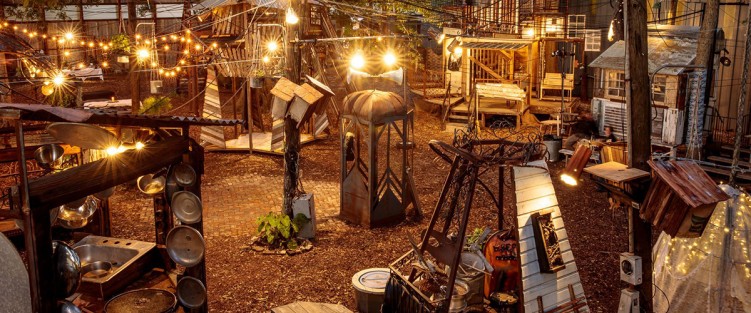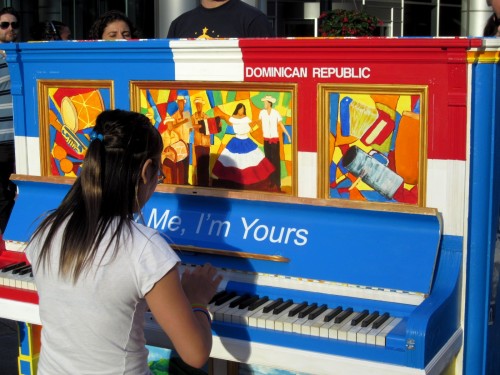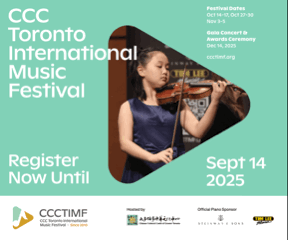 This global health pandemic has certainly illustrated the old Italian proverb, “tutto il mondo è un paese” – indeed, all the world is a village, and every village needs a playground.
This global health pandemic has certainly illustrated the old Italian proverb, “tutto il mondo è un paese” – indeed, all the world is a village, and every village needs a playground.
In my capacity as the executive director of the Regent Park School of Music, I have noticed us, of necessity, growing closer with other community music schools across North America since COVID hit. We have met periodically to discuss the multitude of challenges we have collectively faced, from online learning policies to uses of new technology – a sharing of knowledge between us that has remained open and collaborative, with the greater good of our students in the fore. Many of us in community music seem to be facing the same challenges, so in this article, I will unpack some of these immediate challenges, and also look forward, as best as any of us can, to a post-pandemic landscape that enfolds both music education and community development.
At time of writing this, I had just submitted my PhD dissertation to the University of Toronto, as part of which I ran an instrumental case study of the Music Box Village in New Orleans. Similar to the Reggio Emilia educational movement that developed in Italy the aftermath of World War Two, the Music Box Village was born out of Hurricane Katrina as a response to the social impacts and trauma of its community. This alternative music space wore many hats, functioning partly as a music venue, a learning space, a playground, and much more.
Observing Grade 4 children playing in the space, I noticed that it accepted and fostered multiple intelligences. As an alternative music space, the Music Box Village itself can act as the third teacher, where a student, a teacher and the space itself can simultaneously inform the learning outcomes.
With COVID impacting like a hurricane on the global village, there is something to be learned from the New Orleans experience about musical playgrounds in general and how they can act as a vehicle for community building in the current pandemic’s aftermath. But we are not there yet!
Pandemic Challenges
As we cling to the technology we currently have at our disposal, music educators have quickly realized that the covenant between teacher and student can still be honoured in Zoomland or whatever platform you fancy. To me, the importance of space has always been less significant than those who occupy it, and that also translates to a virtual setting. I am always more interested in the concepts being developed inside of any space, and the humans that bring them to life. Without the people inside the space, it is not much more than an empty shell.
Of course, nothing is better than in-person encounters, but there are enough complaint pieces on that subject. For now, let us focus on what is possible during this important period in our existence. At the end of all of this, our relationships will remain the bedrock that will get us through it, and out the other side. They are what we will retain, those human moments in the midst of the chaos – like the mother entering the Zoom shot to give her daughter a hug after her trumpet performance in a virtual recital.
Music helps us to access and connect those human moments. Over the last year, Regent Park School of Music, along with so many of our community music colleagues, have worked to create safe and accessible spaces, albeit virtual, for students to thrive in, a luxury that the pandemic from a hundred years ago did not have. That safe space could be a virtual open mic night in Zoom, or a file-sharing collaboration that creates something totally new, using the varied technologies at our disposal. Virtual safe space has also opened up collaborative potential between geographically unconnected neighbourhoods (such as Regent Park and Jane and Finch), and also between cities, as we explore ideas with our colleagues at Sarah McLachlan School of Music in Vancouver, and also at The People’s Music School in Chicago, to name a couple.
And on the other side
One thing is certain. The ways we end up teaching and learning will come out of this pandemic looking much different. This is an opportunity, as we all continue to prioritize health and safety, for a reset on the field of music education. Education at large will keep a door open to virtual learning long past this global health challenge. We can now begin to imagine a world more accessible. If it is easier for you to attend your music lesson virtually for the most part, and in person periodically as required, why would we not accommodate that approach?
During this period, children are not necessarily learning math or music online. In this dire era of human existence, they are learning resilience, more so now than ever before. Students of all ages are learning the art of pivoting, wearing multiple hats on multiple platforms, and all at once! We are learning how to make art with the technology we have access to, or providing more access so that relationships between teachers and students can still thrive. As we look at new communities forming among different organizations, networks, cities, we are beginning to look at collaborative projects and outcomes with fresh (and tired) eyes.
Also, the very constraints we are each of us faced with play a role in shaping our musical output – using what we have at our disposal, to remain connected. Might be an old phone, might be one microphone, might be patchy Wi-Fi – it all adds to the look and sound of this new era we find ourselves in. It is all part of the creative recipe for coming out stronger on the other side: the self-expression of a mother reading her poems and editing videos, while her son makes beats and creates the musical backdrop; collaborations within a home that took a pandemic to help incubate. The imagination soars: new music rooms, new musical instruments, virtual reality music rooms, musical playgrounds, new outcomes and collaborations!
I’m not anti-physical space; of course, great things can happen in well-thought-out, accessible spaces. But let us continue to reimagine what the music room can look like when it isn’t necessarily a room. In some cases, let’s remove the walls, or let’s have walls that can be instruments themselves. Inside out is the best way forward. When we take such an open approach, who else will find their way into our music classrooms?
The Music Box Village
Earlier on in this article, I mentioned research I conducted on the impact of the Music Box Village project in post-Katrina New Orleans. What drew me to this particular research was that I already hoped to explore a different path for music educators. Why does a musical curriculum need to be so standardized? Who does really need another Winter Recital? Let us dream of new musical instruments; of projects, collaborations, deliverables, outcomes; of spaces, indoor and out, for musical play. As more and more formal publicly funded music programs are being cut from elementary and high schools there is a growing need for alternative music education models to fill this gap.
Where can a musical playground fit into all this? The answer is it can function in any city, and will take on a distinct reflection of that city’s sonic and cultural traits. Community development, architecture, urban planning and grassroots politics; community health and playground design – from my Music Box Village research, all of these and more will come into play when discovering your musical playground’s potential to help a neighbourhood heal.
It will not necessarily all be plain sailing. An example: with community music models out there such as Luke Jerram’s Play Me, I’m Yours project (which has seen over 2,000 street pianos installed in 65 cities) and others that allow public access to musical experience, the notion of noise in a public space cannot simply be ignored. On this particular topic, I have always supported the concept of choosing, even helping shape, the noise and sonic landscape of one’s community. I can think of a lot less constructive soundscapes in a city or neighbourhood than a musical playground.
It’s a topic that slides easily into related areas, such as playground safety, and the danger in removing all risk from play – not an easy question to resolve, with national-level architecture and design policies to guide developers and planners in their decision making on the one hand, and a resurgence of child-led public play spaces on the other. Both can help cities make wiser long-term decisions around playgrounds. Playground safety is undoubtedly an important consideration, but musical playgrounds allow us to embrace some well-argued tenets: that “art should be dangerous”; and that a certain level of risk in play is actually healthy. Where better than a musical playground, with multiple intelligences being fostered between adults and children alike, for these ideas to run safely wild?
What city in Canada is daring enough to embrace a musical playground? The answer: very likely more now than would have before. As we collectively begin to reimagine our relationship with space, there is an opportunity to turn the corner towards innovative spaces that build community in a bold new way. With institutions of formal learning taking a good look in the mirror, this is also an opportunity to rethink education, and to set up informal learning spaces, because we know that this is where so much of the real learning happens.
 Let this gruelling pause we are in not be in vain, and as we begin to take baby steps in reintegrating as humans, let us all move towards playing more in communal spaces such as the Music Box Village in New Orleans. But here, with our own multiple weirdo Canadian twists on them, celebrating and strengthening the assets in our various communities.
Let this gruelling pause we are in not be in vain, and as we begin to take baby steps in reintegrating as humans, let us all move towards playing more in communal spaces such as the Music Box Village in New Orleans. But here, with our own multiple weirdo Canadian twists on them, celebrating and strengthening the assets in our various communities.
Richard Marsella is executive director at Regent Park School of Music. His recent doctoral dissertation, The Musical Playground as a Vehicle for Community-Building, is available online via the University of Toronto. To donate to the Regent Park School of Music, visit rpmusic.org.



